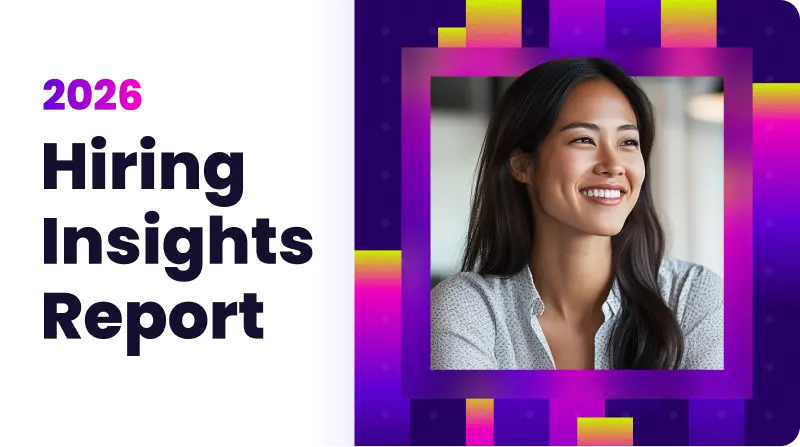Table of Contents
Let’s be honest: talent acquisition has never been more complex—or more critical. The pressure to fill roles faster, personalize every candidate touchpoint, and keep recruiters from burning out isn’t letting up. And all of this is happening as teams face shrinking headcounts and tighter budgets.
But something new is quietly transforming how work gets done in talent acquisition. A different kind of teammate has joined the ranks—not another recruiter or coordinator, but intelligent software. AI tools that schedule interviews. Digital agents that send personalized reminders. AI and automation that eliminates hours of manual work. This is digital labor.
Digital labor, sometimes referred to as a “digital workforce,” represents a class of software-driven assistants that can handle many of the tedious, repetitive tasks traditionally performed by people. Think of them as ultra-efficient interns: fast, tireless, and accurate—but still in need of guidance and guardrails. And when implemented strategically, they can free up your human team to focus on what truly drives great hiring: relationships, judgment, and creativity.
In this article, we’ll break down what digital labor really means in the context of talent acquisition. We’ll look at where it’s already delivering results, how forward-thinking teams are putting it to work, and what it takes to adopt it successfully. You’ll also hear examples of how tools like GoodTime are being used—not as a replacement for recruiters, but as force multipliers that enable them to do their best work.
Because when digital labor is done right, it doesn’t make recruiting less human. It makes it more human.

Unlock 2026’s top hiring strategies: Insights from 500+ TA leaders
Be the first to uncover deep hiring insights specific to your sector — straight from the highest-performing TA teams.

A new kind of teammate: The rise of digital labor in recruiting
If you’ve worked in talent acquisition long enough, you’ve seen the evolution firsthand. From spreadsheets to applicant tracking systems. From faxed resumes to AI-powered sourcing. Each wave of innovation promised to make hiring faster, better, and easier.
Now we’re entering a new phase—one that doesn’t just upgrade your tools but introduces entirely new types of “workers” to your team.
This is the rise of digital labor: software-based agents that take on real work once performed exclusively by people. They don’t punch timecards or show up to team meetings, but they’re deeply embedded in your processes—scheduling interviews, messaging candidates, syncing calendars, and even nudging hiring managers to submit feedback. And they do it all with remarkable speed, accuracy, and consistency.
The idea isn’t hypothetical. As Salesforce CEO Marc Benioff stated at the World Economic Forum in Davos, “We are really moving into a world now of managing humans and agents together.” In many talent teams, that shift has already started. And not in the flashy, sci-fi way people tend to imagine—but in practical, behind-the-scenes ways that are quietly changing how hiring happens.
Digital labor is showing up everywhere:
- A scheduling assistant that finds time for a multi-round panel faster than any human could
- A chatbot that answers candidate questions at 11 p.m. on a Sunday
- A workflow that texts reminders before interviews and captures feedback after
- An AI-powered system that flags bottlenecks in your hiring funnel before they become problems
This isn’t about gimmicks. It’s about performance. At a time when most enterprise TA teams are expected to do more with less, digital labor offers a way to scale without sacrificing experience or control.
“We are really moving into a world now of managing humans and agents together.”
-Marc Benioff, CEO, Salesforce
Take GoodTime, for example. Enterprise teams use its agentic AI to fully automate complex interview scheduling—across time zones, teams, and roles. Instead of relying on recruiters to juggle calendars manually, the AI finds optimal times, selects interviewers, and even reschedules automatically when someone drops out. That’s not a hypothetical use case—it’s happening every day in companies like Salesforce and DoorDash.
But GoodTime is just one example in a broader movement. Across the TA landscape, digital labor is helping teams reclaim hours of lost time and redirect that energy toward more strategic, human-centered work. What’s important to understand is that this shift isn’t coming—it’s already here. The only question is how you’ll choose to engage with it.
What digital labor really is (and isn’t)
When people hear the term digital labor, it often conjures up images of humanoid robots or sci-fi depictions of AI run amok. But the reality is far less cinematic—and far more practical.
Digital labor in talent acquisition is about intelligent software systems that perform tasks previously handled by humans. These digital “workers” or AI agents for talent acquisition aren’t physical machines; they’re software agents living inside your hiring tech stack. They schedule interviews, answer candidate questions, generate job descriptions, and route data—all with minimal human input.
Think of them as the world’s most diligent interns: fast, reliable, and not prone to burnout. But like any intern, they don’t just show up ready to roll. They require setup, training, and oversight. You need to define their workflows, feed them clean data, and monitor their performance over time.
That’s the key distinction: digital labor doesn’t replace process ownership. It follows the processes we create and amplifies them.
Let’s break it down. A well-configured AI scheduling assistant, for example, will:
- Parse calendars and time zones faster than a human coordinator ever could
- Suggest the best interviewer panel based on skill tags and availability
- Auto-reschedule if someone drops out
- Notify candidates through branded emails or text messaging, instantly
But it won’t decide why a particular interviewer is needed for a specific role. It won’t know when to overrule its own logic to preserve a candidate relationship. That’s still human territory.
GoodTime’s approach to this balance is a strong example. The platform enables TA teams to configure how much automation they want in their scheduling process. Want full auto-confirmation for high-volume roles? Done. Prefer a manual check for executive interviews? You’re in control. The AI doesn’t dictate process—it supports it.
That’s what makes digital labor so powerful. It scales your thinking. When used intentionally, it executes your recruiting strategies with speed and consistency, without forcing you to sacrifice personalization or judgment.
And let’s be clear about what digital labor isn’t. It’s not a chatbot trying to replace your sourcers. It’s not a black-box algorithm deciding who gets hired. And it’s definitely not about cutting your recruiting headcount in half to “let the AI take over.”
What it is—at its best—is a new kind of team member. One that never sleeps, never misses a task, and makes your human team better by freeing them to focus on what they do best.
Where digital labor is making the biggest impact
If you’re wondering where to start with digital labor, look no further than the bottlenecks your team encounters regularly. The most successful TA leaders don’t begin with sweeping transformations—they start with the repeatable, time-consuming tasks that hinder great recruiting.
Here are five areas where digital labor is already making a tangible difference inside large enterprise recruiting teams:
1. Interview scheduling and coordination
It’s the classic time sink: back-and-forth emails, calendar conflicts, last-minute changes. For many recruiting coordinators, this consumes a significant portion of their week.
Digital labor alleviates this burden.
Platforms like GoodTime utilize AI-driven interview scheduling agents that manage the entire coordination process—from finding optimal times across multiple calendars and time zones to automatically replacing interviewers who cancel. This automation has led companies to experience up to a 50% reduction in time-to-hire and a significant decrease in manual rescheduling efforts.
2. Candidate engagement and communication
Candidates today expect prompt, transparent communication, and ghosting has become a dealbreaker. Digital labor helps bridge this gap.
Hilton, for instance, implemented an AI-powered chatbot named “Connie” to handle routine candidate inquiries, provide updates on application statuses, and guide applicants through the process. This not only enhanced candidate engagement but also allowed HR teams to focus on more complex tasks.
Additionally, Hilton’s use of AI in recruitment led to a reduction in time-to-hire from 43 days to just 5, demonstrating the efficiency of automated candidate communications.
3. Sourcing and screening at scale
Manual resume reviews are time-consuming and often inconsistent. Digital labor standardizes and accelerates this step without compromising quality.
Unilever revamped its recruitment process by incorporating AI-driven assessments and video interviews. This transformation resulted in a 75% reduction in hiring time and over £1 million in annual cost savings. Moreover, it improved candidate diversity and experience.
4. Data hygiene and process tracking
An ATS full of inconsistencies or outdated information can hinder the recruiting process. Digital labor addresses this by keeping systems synchronized.
AI-powered tools can automatically update candidate statuses, log interactions, and ensure that data across platforms remains consistent and up-to-date. This leads to more accurate reporting and better decision-making.
5. Compliance, consistency, and personalization at scale
Digital labor enforces process consistency across various roles and locations, ensuring that each candidate interaction aligns with company standards.
For example, AI-driven platforms can send personalized messages to candidates, reflecting company branding and maintaining a consistent tone. This balance of automation and personalization enhances the candidate experience while upholding compliance standards.
The takeaway is clear: digital labor is not confined to one aspect of recruiting. It permeates every stage of the funnel, offering efficiency and scalability without diminishing the human touch in hiring.
Why it’s not about replacing recruiters — it’s about freeing them
Let’s address the elephant in the room: fear.
For many recruiting teams, the rise of AI in hiring brings a quiet but persistent worry—what happens to my role when a bot can schedule interviews faster than I can? It’s a fair question. But the most successful TA leaders today aren’t treating digital labor as a threat. They’re treating it as a teammate.
Digital labor, when implemented thoughtfully, doesn’t reduce the need for recruiters. It reduces the burden on them. It removes the tedious, manual, high-volume work that eats up hours every week—so they can focus on the work that actually requires human intelligence: building relationships, advising hiring managers, storytelling around employer brand, and guiding candidates through big career decisions.
Let’s bring in the data. In GoodTime’s Hiring Insights Report, 99% of TA teams reported using some form of automation or AI in the past year. But what’s more telling is how they’re using it. The top use cases? Interview scheduling, screening, candidate communication, and data tracking—exactly the kinds of repetitive tasks that digital labor handles best.
When Hilton implemented its AI chatbot to support candidate engagement, it wasn’t to replace its talent team. It was to give them breathing room. Recruiters were able to step away from answering routine questions and instead focus on creating more meaningful candidate conversations. That’s what digital labor enables: deeper impact, not fewer jobs.
Same goes for companies using tools like GoodTime. Their agentic AI coordinates complex interviews, fills last-minute gaps, and handles time zone headaches—often automating up to 90% of scheduling tasks. But the result isn’t a leaner team. It’s a more strategic one. Recruiters get time back to refine their sourcing strategies, improve pass-through rates, or deliver high-touch moments that can’t be automated.
It’s what GoodTime calls a human-centric AI philosophy: the idea that technology should serve people, not replace them. “We believe in using AI to really augment humans, not to replace them,” says CEO Ahryun Moon. “The goal is to offload the mundane and give people more time for the work that matters.”
This “human-in-the-loop” model—where digital labor handles the heavy lifting and defers to humans for judgment calls—is quickly becoming the gold standard. AI sends the reminders, confirms the logistics, flags the anomalies. Humans guide the strategy, make the tough decisions, and build the trust that ultimately lands great hires.
The irony of digital labor is that it doesn’t dehumanize recruiting. Done well, it makes it more human. It gives your team space to be curious, creative, and connected. It lets recruiters be what they were always meant to be: talent advisors, not task managers.
What successful adoption looks like in enterprise TA teams
Let’s face it: it’s easy to get swept up in the AI hype. But when it comes to digital labor, success isn’t about having the flashiest chatbot or the most futuristic dashboard—it’s about solving real problems, saving time, and unlocking your team’s potential.
So, what does it actually look like to roll out digital labor in a way that sticks?
Start with a pain point, not a platform
The most effective enterprise teams don’t begin with tech for tech’s sake. They start with a clear bottleneck.
Maybe it’s interview scheduling, where recruiters are losing full days to back-and-forth emails. Maybe it’s candidate ghosting, where slow follow-up is tanking your funnel. Maybe it’s data inconsistencies between your ATS and calendar systems.
The key is to anchor your automation strategy to a visible, measurable challenge. That’s how you build momentum—and secure executive buy-in.
Pilot with purpose
Once you’ve picked the right use case, start small and intentional.
A focused pilot lets you test the tech, gather baseline data, and involve your team early—before change management becomes an uphill battle. Choose one region, one department, or one hiring stage to roll out digital labor.
For example, many companies implement GoodTime initially to tackle high-volume interview coordination for specific roles or events, like Superdays. In doing so, they can quickly quantify impact (e.g. scheduling time cut by 80%, interview no-shows down 30%) and generate internal champions who’ll advocate for broader adoption.
Bring your recruiters along for the ride
This part is non-negotiable.
If recruiters feel like automation is happening to them, not for them, resistance will follow. But when they’re looped in early—helping shape workflows, giving feedback, and seeing how digital labor reduces their busywork—they become powerful allies.
In fact, several enterprise TA leaders featured in the Hiring Insights Report said their teams were more engaged after implementing digital assistants. Why? Because they finally had time to focus on the high-impact, human parts of recruiting.
Measure what matters
Digital labor should lead to real outcomes—not just “feels faster.”
Top-performing enterprise teams track metrics like:
- Time-to-schedule and time-to-hire
- Interviewer utilization and load balancing
- Candidate no-show rates
- Scheduling error rates
- Recruiter capacity (reqs per head)
And yes, they track adoption rates too—because no AI is helpful if no one’s using it.
HelloFresh, for example, was able to fill roles 15 days faster on average with GoodTime. That’s an efficiency gain you can take to the CFO.
Keep a human in the loop
Even as you scale automation, build in guardrails for nuance and oversight.
GoodTime, for instance, allows teams to choose how much control they want—whether that’s full auto-confirmation for high-volume roles or manual approvals for executive hires. The best implementations strike that balance: giving AI the wheel for the routine, and routing edge cases to human hands.
That’s how you ensure your digital workforce complements, not complicates, your human one.
Done right, digital labor doesn’t just “cut time”—it transforms how your team operates. It empowers people to spend less energy on admin and more energy on impact.
And when that happens, hiring gets faster, candidates feel seen, and your TA team gets the credit it deserves.
Embracing digital labor as a strategic advantage
We’re not talking about the future of recruiting anymore. We’re living it.
Digital labor has arrived—and it’s already reshaping how enterprise talent teams operate. It’s not just about speed or scale (though you’ll absolutely get both). It’s about building a recruiting function that’s more resilient, more strategic, and more human.
In the last few years, we’ve seen the pressure mount: tighter teams, higher req loads, rising candidate expectations, and relentless demands for efficiency. And yet, TA leaders have responded not just by coping—but by evolving. They’ve turned to automation, AI, and intelligent systems to carry the operational weight. They’ve embraced a new kind of teammate: one that never sleeps, never forgets a reminder, and never flakes on a calendar hold.
The results speak for themselves.
- Faster time-to-hire
- Better candidate experiences
- More consistent data and process
- Recruiters with time to focus on what matters most
And crucially, this evolution isn’t about cutting corners or headcount. It’s about elevating your team. Digital labor doesn’t replace people—it releases them. From the spreadsheet hell. From the reschedule ping-pong. From the friction that slows hiring and exhausts your staff.
Tools like GoodTime, Hilton’s chatbots, Unilever’s AI screening platform, and others are proof: when digital labor is done right, it frees people to be more human, not less.
So if you’re leading a talent acquisition team right now, here’s the call to action:
- Identify your team’s friction points
- Look for low-risk, high-reward areas to introduce automation
- Choose platforms that align with your values and give you control
- Involve your recruiters, measure outcomes, and iterate fast
Most importantly, adopt the mindset that digital labor isn’t a threat—it’s an opportunity. An opportunity to do the same job you’ve always done: build great teams. Just with better tools, less stress, and more time to focus on what actually drives hiring success.
Because in the end, hiring is about people. Digital labor just gives you the bandwidth to treat them like it.




